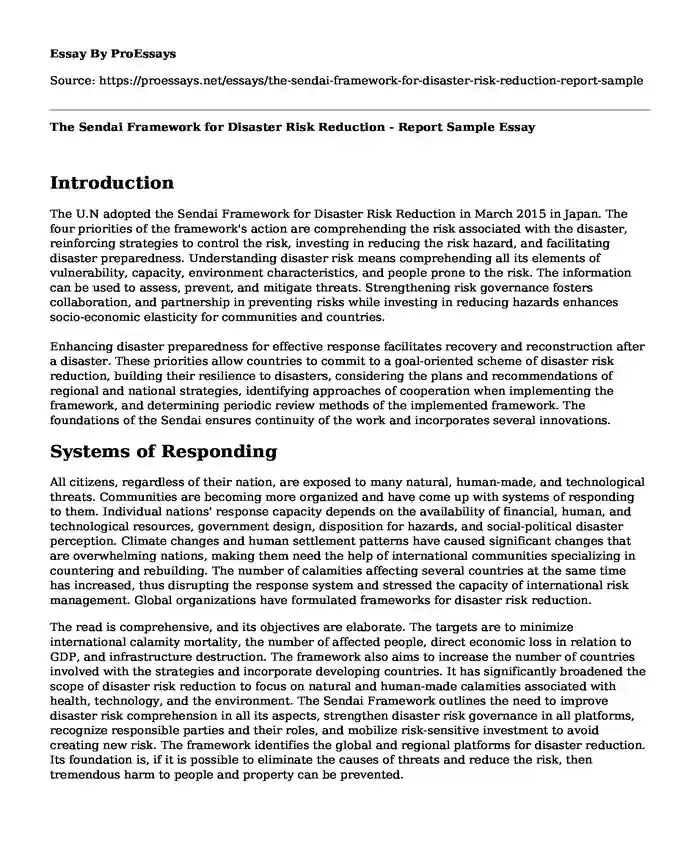Introduction
The U.N adopted the Sendai Framework for Disaster Risk Reduction in March 2015 in Japan. The four priorities of the framework's action are comprehending the risk associated with the disaster, reinforcing strategies to control the risk, investing in reducing the risk hazard, and facilitating disaster preparedness. Understanding disaster risk means comprehending all its elements of vulnerability, capacity, environment characteristics, and people prone to the risk. The information can be used to assess, prevent, and mitigate threats. Strengthening risk governance fosters collaboration, and partnership in preventing risks while investing in reducing hazards enhances socio-economic elasticity for communities and countries.
Enhancing disaster preparedness for effective response facilitates recovery and reconstruction after a disaster. These priorities allow countries to commit to a goal-oriented scheme of disaster risk reduction, building their resilience to disasters, considering the plans and recommendations of regional and national strategies, identifying approaches of cooperation when implementing the framework, and determining periodic review methods of the implemented framework. The foundations of the Sendai ensures continuity of the work and incorporates several innovations.
Systems of Responding
All citizens, regardless of their nation, are exposed to many natural, human-made, and technological threats. Communities are becoming more organized and have come up with systems of responding to them. Individual nations' response capacity depends on the availability of financial, human, and technological resources, government design, disposition for hazards, and social-political disaster perception. Climate changes and human settlement patterns have caused significant changes that are overwhelming nations, making them need the help of international communities specializing in countering and rebuilding. The number of calamities affecting several countries at the same time has increased, thus disrupting the response system and stressed the capacity of international risk management. Global organizations have formulated frameworks for disaster risk reduction.
The read is comprehensive, and its objectives are elaborate. The targets are to minimize international calamity mortality, the number of affected people, direct economic loss in relation to GDP, and infrastructure destruction. The framework also aims to increase the number of countries involved with the strategies and incorporate developing countries. It has significantly broadened the scope of disaster risk reduction to focus on natural and human-made calamities associated with health, technology, and the environment. The Sendai Framework outlines the need to improve disaster risk comprehension in all its aspects, strengthen disaster risk governance in all platforms, recognize responsible parties and their roles, and mobilize risk-sensitive investment to avoid creating new risk. The framework identifies the global and regional platforms for disaster reduction. Its foundation is, if it is possible to eliminate the causes of threats and reduce the risk, then tremendous harm to people and property can be prevented.
Conclusion
The framework focuses more on disaster risk management than disaster management. This means that it aims to prevent and reduce existing disaster risks and strengthen resilience instead of dealing with disasters when they occur. In my opinion, the framework should include strategies for dealing with calamities when they happen because most disasters are unpredictable and uncontrollable. Therefore, it is crucial to develop mechanisms, operations, and fair practices to handle the calamities more effectively. Effective disaster response includes providing technology, apparatus, and methodologies that allow disaster response institutions to manage data from multiple sources and collaborate effectively to help the survivors, alleviate damage, and help communities recover.
Cite this page
The Sendai Framework for Disaster Risk Reduction - Report Sample. (2024, Jan 01). Retrieved from https://proessays.net/essays/the-sendai-framework-for-disaster-risk-reduction-report-sample
If you are the original author of this essay and no longer wish to have it published on the ProEssays website, please click below to request its removal:
- The Global Warming: Easy Ways to Prove
- Argumentative Essay: Corporate Communication and Impression Management
- Implications and Challenges for Traditional Organizational Management Essay
- Air Pollution, Global Warming and Climate Change Paper Example
- Paper Example on CVS Health & Walgreens: Perfect Examples of Organizational Structure & Culture
- Design Control for Particulate-Phase Pollutants: Cyclones, Electrostatic Collection & Filtration
- Paper on Agile at Scale: Revolutionizing Leadership and Supply Chain Management for Business Excellence







